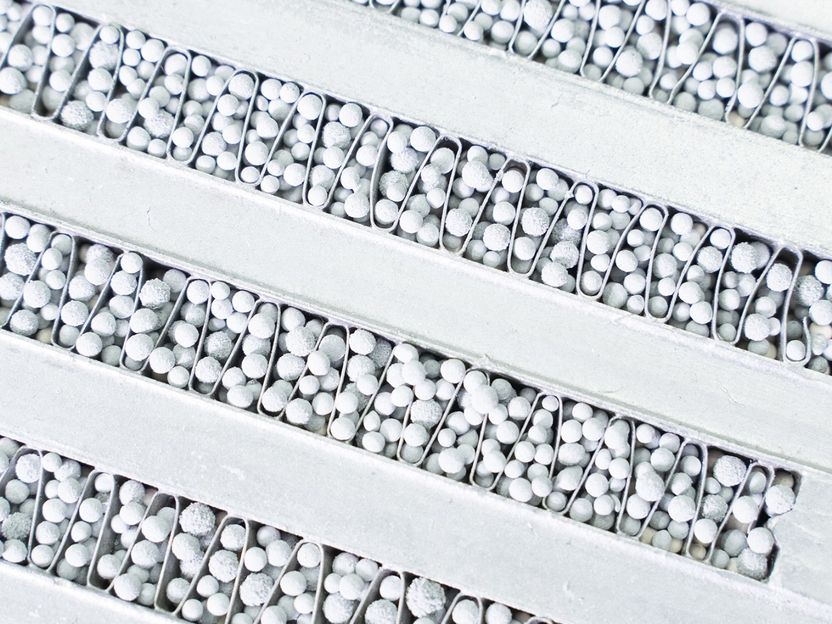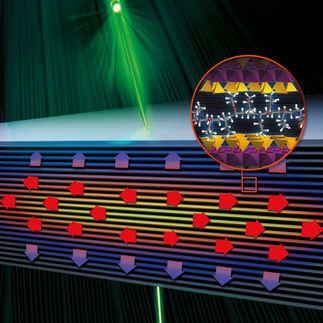Thermal storage for the energy transition
The energy is not stored in the form of increased heat but in the form of a chemical state
Advertisement
In Germany, 55 percent of final energy consumption goes towards heating and cooling. However, a lot of heat dissipates unused because it is not generated as and when required. Thermal storage using zeolite material allows heat to be stored for long periods of time without losing any. Fraunhofer researchers are now working on significantly improving the thermal conductivity of zeolites.

Heat exchanger with metallized zeolite.
© Fraunhofer FEP
Many roofs nowadays host solar collectors that provide homes with warm water. This works quite well in the summer; however, heating demand peaks in the winter when homes need heating. Thermal storage therefore needs to be able to store a portion of the excess heat for use at a later date. Traditionally, large water tanks have been used for this purpose; water is heated in these tanks and the heat is then directly stored as heat. The problem with this method is that large volumes are required, and in spite of good insulation, heat is also lost. In contrast, thermochemical storage enables thermal energy produced in the summer to be preserved for use in the cold winter. Zeolites are one such storage solution. Unlike water, zeolites do not store the heat directly – instead, the heat removes the water that is stored within the material. In the energetic state, zeolites are therefore completely dry; conversely, when water vapor is passed through the pellets, heat is released. The advantage of this is that the energy is not stored in the form of increased heat but in the form of a chemical state. This means that heat is not lost during long-term storage. There is one drawback: Zeolites have poor thermal conductivity, which makes transferring the heat from the heat exchanger to the material and back difficult.
Coating with aluminum
A team of researchers at the Fraunhofer Institute for Organic Electronics, Electron Beam and Plasma Technology FEP have now solved this problem through their work on the ZeoMet project. “We coated the zeolite pellets with aluminum – this doubled thermal conductivity after just the first attempt without negatively impacting water adsorption and desorption. We are currently aiming to increase this by five to ten times through adjusting the coatings,” says Dr. Heidrun Klostermann, Project Manager at Fraunhofer FEP. While this sounds relatively simple, it actually poses considerable challenges. This means that for a liter of granules with a five millimeter-diameter grain size, around ten thousand of these tiny pellets must be evenly coated with aluminum. For a grain size of one millimeter, this amounts to one million pellets with an overall surface area of 3.6 m2. The smaller the grain, the more challenging the process. However, smaller grains also increase the specific power density of thermal storage systems. In order to achieve sufficient thermal conductivity, the coat must also be tens of micrometers thick – for vacuum coating processes, this is a lot thicker than the norm.
Nevertheless, the researchers conquered these challenges. To do so, they looked to thermal evaporation, whereby aluminum wire is continuously fed onto a heated ceramic plate in a vacuum, where the aluminum is evaporated and deposited onto the granules as a layer of aluminum. The pellets must be continually circulated in a barrel so that they are all covered evenly. “The main difficulty lay in coating the granules while they roll around as well as ensuring that the coating was applied evenly to a sufficient degree,” says Klostermann. “The excellent collaboration of our engineers, physicists and precision mechanics was the principal asset in helping us to achieve this.”
Also an option for cooling
Not only are zeolites a good method of thermal storage: They can also help provide cooling for domestic use alongside solar collectors as well as for mobile applications. For example, in commercial vehicles, heat lost from the power unit could be used for air conditioning as part of a thermochemical cycle. From the viewpoint of the Fraunhofer FEP researchers, the hybrid materials used for this present new challenges. As a result, the scientists are looking to strengthen their connections with materials developers and systems engineers from research and industry, in the hopes of advancing solutions for the flexible supply of heating and cooling.

































































